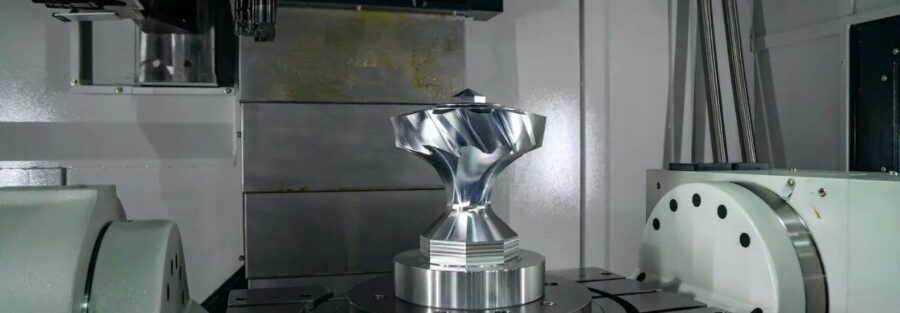
5-Axis Machining represents a significant advancement in manufacturing, offering capabilities far beyond traditional three-axis machining. It’s a process that allows for the creation of complex shapes and intricate designs with greater precision and efficiency. But what exactly are these five axes, and how do they work together? Let’s break it down.
5-Axis Machining:
| Feature | 3-Axis Machining | 5-Axis Machining |
| Linear Axes | X, Y, Z | X, Y, Z |
| Rotary Axes | None | A (rotation around X), B (rotation around Y), and/or C (rotation around Z) – configurations vary |
| Part Complexity | Limited to simpler geometries | Highly complex geometries, including undercuts and intricate details |
| Number of Setups | Multiple setups often required for complex parts | Fewer setups, often a single setup |
| Accuracy | Lower accuracy due to multiple setups | Higher accuracy due to fewer setups and reduced part handling |
| Surface Finish | Can be challenging to achieve optimal surface finish on complex parts | Improved surface finish due to better tool orientation |
| Design Freedom | Limited design possibilities | Greater design freedom, enabling more complex and innovative designs |
| Setup Time | Longer setup times due to multiple part repositioning | Shorter setup times due to fewer part repositioning |
| Tooling Costs | Can be higher for complex parts requiring specialized tooling | Can be lower in some cases due to the ability to use standard tools in more orientations |
| Programming Complexity | Simpler programming | More complex programming requiring specialized CAM software and expertise |
| Machine Cost | Lower initial investment | Higher initial investment |
| Operator Skill | Requires less specialized training | Requires highly skilled operators with specialized training |
| Applications | Primarily for simpler parts and geometries | Aerospace, automotive, medical, tool and die, energy, and other industries requiring complex parts |
| Advantages | Lower initial cost, simpler programming | Reduced setup times, increased accuracy, improved surface finish, greater design freedom, reduced tooling costs in some cases, higher efficiency |
| Disadvantages | Limited part complexity, lower accuracy, longer setup times | Higher initial cost, complex programming, requires skilled operators |
Imagine a standard three-axis CNC machine. It can move a cutting tool along three linear axes:
- X-axis: Movement from left to right.
- Y-axis: Movement forward and backward.
- Z-axis: Movement up and down.
These three axes allow for creating a wide range of parts, but they have limitations when it comes to complex geometries. This is where the fourth and fifth axes come into play. These additional axes are rotary, allowing for tilting and rotating the workpiece or the cutting tool itself. There are several configurations for these rotational axes, but two common ones are:

- A-axis: Rotation around the X-axis (tilting).
- B-axis: Rotation around the Y-axis (tilting in a different direction).
- C-axis: Rotation around the Z-axis (like a spinning table).
How 5-Axis Machining Works:
The magic of 5-axis machining lies in the coordinated movement of all five axes simultaneously. This allows the cutting tool to approach the workpiece from virtually any angle, enabling the creation of complex contours, undercuts, and intricate details in a single setup. Instead of having to reposition the part multiple times (which introduces potential inaccuracies), the machine can manipulate the workpiece or the tool to access all necessary surfaces.
Benefits of 5-Axis Machining:
- Reduced Setup Times: Fewer setups mean less time spent preparing the part for machining, leading to faster production cycles.
- Increased Accuracy: By minimizing the number of setups, the risk of errors associated with repositioning the part is significantly reduced, resulting in higher precision.
- Improved Surface Finish: The ability to orient the workpiece optimally allows for better control of the cutting process, leading to smoother and more consistent surface finishes.
- Greater Design Freedom: 5-axis machining opens up new possibilities for designers, allowing them to create complex shapes that would be impossible or very difficult to manufacture with traditional methods.
- Reduced Tooling Costs: In some cases, complex parts that previously required specialized tooling can be machined with standard tools using 5-axis techniques.
- Higher Efficiency: The ability to machine complex parts in a single setup reduces overall production time and increases efficiency.
Applications of 5-Axis Machining:
5-axis machining is used in a wide range of industries, including:
- Aerospace: Manufacturing complex turbine blades, engine components, and structural parts.
- Automotive: Producing intricate molds, dies, and prototypes.
- Medical: Creating custom implants, prosthetics, and surgical instruments.
- Tool and Die: Fabricating complex molds and dies for various manufacturing processes.
- Energy: Machining components for wind turbines, oil and gas exploration, and other energy-related applications.
Challenges of 5-Axis Machining:
While 5-axis machining offers numerous advantages, it also presents some challenges:
- Higher Initial Investment: 5-axis machines are more expensive than traditional 3-axis machines.
- Complex Programming: Programming 5-axis machining operations requires specialized CAM software and skilled programmers.
- Skilled Operators: Operating 5-axis machines requires a high level of expertise and training.
In Conclusion:
Five-axis machining is a powerful and versatile manufacturing technology that enables the creation of complex and highly precise parts. While it requires a higher initial investment and specialized skills, the benefits in terms of reduced setup times, increased accuracy, improved surface finish, and greater design freedom make it an invaluable tool for a wide range of industries. As technology continues to advance, 5-axis machining is likely to become even more prevalent in manufacturing, pushing the boundaries of what is possible.




